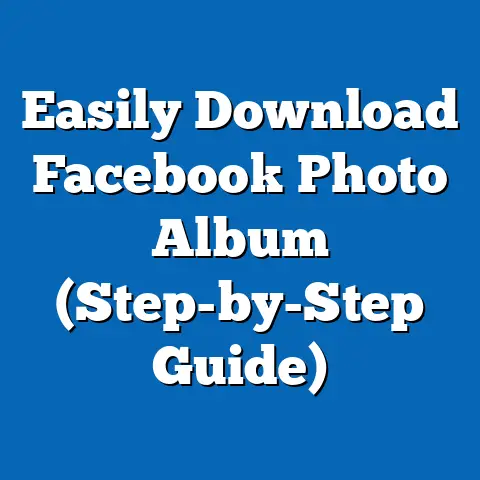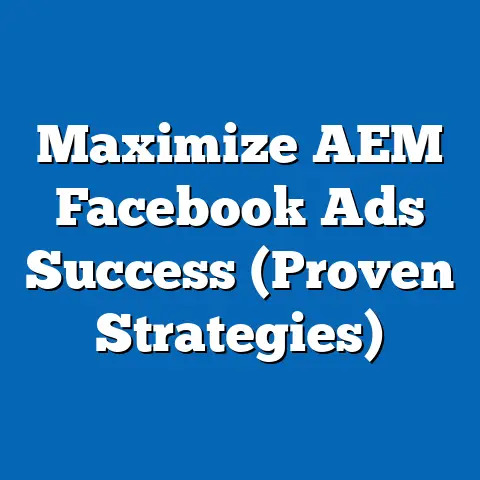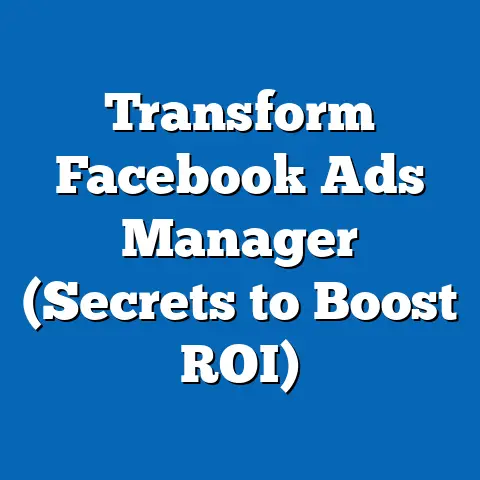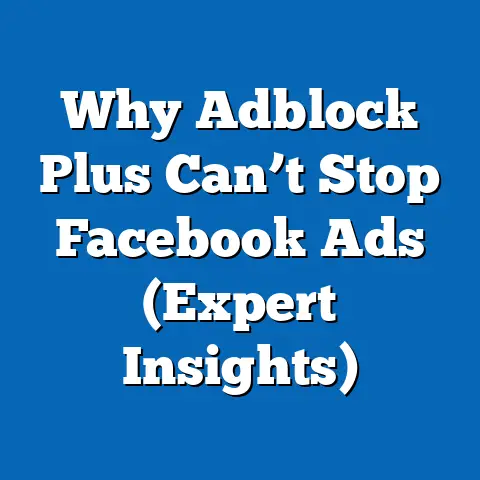The Evolution of Facebook Ads (Timeline Breakdown)
I’ve always believed that marketing, at its heart, is about connection. It’s about building relationships, understanding needs, and offering solutions with genuine warmth. In the digital age, platforms like Facebook have become the modern-day town square, where people connect, share, and discover. And within this digital landscape, Facebook Ads have evolved from simple text-based messages to sophisticated, personalized experiences.
Facebook, now known as Meta, has transformed how businesses reach their audiences, offering unparalleled targeting capabilities and a platform that’s constantly adapting. In this article, I want to take you on a journey through the evolution of Facebook Ads, highlighting the key milestones and developments that have shaped the platform into what it is today. Think of it as tracing the path of a warm, friendly conversation, from a simple “hello” to a deeply engaging dialogue.
The Birth of Facebook Ads (2004-2007)
Back in 2004, when Mark Zuckerberg launched “The Facebook,” advertising was far from the platform’s initial focus. The primary goal was to connect college students, and the platform grew organically through word-of-mouth and a genuine desire for social interaction. It was a digital dorm room, free from the clutter of marketing messages.
What made these early ads different was the ability to target users based on their self-reported information. Advertisers could specify demographics like age, location, and education, allowing them to reach a more relevant audience than traditional online advertising methods. This was a game-changer. Instead of casting a wide net, businesses could now focus their efforts on individuals who were more likely to be interested in their products or services.
I remember when these ads first appeared. As a budding marketer, I was fascinated by the potential. It was like having a direct line to specific groups of people, a way to tailor messages and speak directly to their needs. The simplicity of these early ads was deceptive; they represented a fundamental shift in how businesses could connect with their customers.
Key Takeaway: The introduction of Facebook Ads in 2007 marked the beginning of targeted online advertising, allowing businesses to reach specific demographics based on user data. This was a significant departure from traditional advertising methods and laid the foundation for the platform’s future growth.
The Introduction of Targeting and Custom Audiences (2008-2012)
Demographic targeting became more granular, allowing advertisers to specify age ranges, genders, education levels, and relationship statuses. Interest-based targeting enabled businesses to reach users who had expressed interest in specific topics, hobbies, or activities. Geographic targeting allowed advertisers to focus their campaigns on specific locations, from countries and regions to cities and even zip codes.
But the real game-changer came in 2012 with the launch of Custom Audiences. This feature allowed advertisers to upload their own customer data, such as email addresses and phone numbers, and match it to Facebook users. This meant that businesses could now target their existing customers with personalized ads, creating a more seamless and relevant experience.
I recall the excitement when Custom Audiences were first announced. It was like unlocking a secret weapon in the marketing arsenal. The ability to reach existing customers with tailored messages was incredibly powerful. We started experimenting with different customer segments, creating ads that spoke directly to their past purchases, preferences, and behaviors. The results were astounding. We saw a significant increase in engagement, conversion rates, and overall ROI.
The introduction of these advanced targeting options transformed Facebook Ads from a simple advertising platform into a sophisticated marketing tool. Businesses could now create highly targeted campaigns that resonated with specific audiences, fostering a sense of warmth and connection that was previously unattainable.
Key Takeaway: The introduction of advanced targeting options, including demographic, interest-based, geographic, and Custom Audiences, revolutionized Facebook advertising by allowing businesses to reach specific audiences with personalized messages.
The Rise of Visual Content and Engagement (2013-2015)
As Facebook’s user base continued to grow, the platform became increasingly visual. Users were sharing photos, videos, and other visual content at an unprecedented rate, and Facebook responded by introducing new ad formats that leveraged the power of visual storytelling.
In 2013, Facebook introduced photo ads, allowing advertisers to showcase their products or services with compelling images. This was a significant upgrade from the text-based ads of the past, as visuals have a much greater impact on user engagement. A picture, after all, is worth a thousand words.
The following year, Facebook launched the carousel ad format, which allowed advertisers to display multiple images or videos in a single ad unit. This format was particularly effective for showcasing a range of products, highlighting different features, or telling a story in a visually engaging way.
Around this time, mobile advertising also began to take center stage. With more and more users accessing Facebook on their smartphones and tablets, the platform recognized the need to optimize ads for mobile devices. This meant creating ads that were visually appealing, easy to read, and quick to load on smaller screens.
I remember the shift towards visual content and mobile advertising. It felt like a natural evolution, driven by the changing habits of Facebook users. We started experimenting with different visual formats, creating ads that were both informative and aesthetically pleasing. We also focused on optimizing our ads for mobile devices, ensuring that they looked great and loaded quickly on smartphones and tablets.
The rise of visual content and mobile advertising transformed Facebook Ads into a more immersive and engaging experience. Businesses could now create ads that captured the attention of users, told compelling stories, and fostered a sense of connection on a deeper level.
Key Takeaway: The introduction of photo and video ads, along with the rise of mobile advertising, transformed Facebook Ads into a more visually engaging and immersive experience, allowing businesses to connect with users on a deeper level.
The Era of Advanced Analytics and AI (2016-2019)
The years between 2016 and 2019 marked a significant shift towards data-driven advertising, driven by the integration of advanced analytics tools and machine learning algorithms. Facebook introduced a range of new features that allowed advertisers to track user behavior, measure conversion rates, and optimize ad performance in real-time.
One of the most important of these features was the Facebook Pixel, a small piece of code that advertisers could install on their websites to track user actions. The Pixel allowed businesses to see which ads were driving traffic, which products were being purchased, and which users were converting into customers. This data was invaluable for optimizing ad campaigns and improving ROI.
Facebook also began to leverage machine learning to automate many of the tasks associated with advertising. The platform’s algorithms could now automatically optimize ad delivery, targeting, and bidding, ensuring that ads were shown to the right people at the right time and at the right price.
I remember being amazed by the power of these new analytics tools and machine learning algorithms. It was like having a team of data scientists working behind the scenes, constantly analyzing and optimizing our ad campaigns. We started using the Facebook Pixel to track user behavior on our websites, and we used the platform’s automated bidding tools to optimize our ad delivery. The results were remarkable. We saw a significant improvement in our conversion rates, a reduction in our ad costs, and an overall increase in our ROI.
The integration of advanced analytics and AI transformed Facebook Ads into a more sophisticated and effective marketing tool. Businesses could now leverage data to make informed decisions, automate key tasks, and optimize their ad campaigns for maximum impact.
Key Takeaway: The integration of advanced analytics tools and machine learning algorithms transformed Facebook Ads into a data-driven platform, allowing businesses to track user behavior, measure conversion rates, and optimize ad performance in real-time.
The Impact of Privacy Regulations and Changes in User Behavior (2020-Present)
The past few years have been marked by significant changes in the advertising landscape, driven by increased privacy regulations and shifts in user behavior. Regulations like GDPR (General Data Protection Regulation) and CCPA (California Consumer Privacy Act) have placed greater restrictions on how businesses can collect and use user data.
These regulations have had a significant impact on Facebook Ads. Advertisers now need to be more transparent about how they are collecting and using user data, and they need to obtain explicit consent from users before tracking their behavior. This has made it more difficult to target ads effectively and has led to a decrease in the accuracy of audience targeting.
In addition to privacy regulations, changes in user behavior have also posed challenges for Facebook Ads. Users are becoming increasingly skeptical of targeted ads, and they are more likely to ignore or block ads that they find intrusive or irrelevant. This has led to increased ad fatigue and a decrease in engagement rates.
I’ve seen firsthand the impact of these changes on our Facebook ad campaigns. We’ve had to adapt our strategies to comply with new privacy regulations, and we’ve had to find new ways to engage users who are becoming increasingly skeptical of targeted ads. We’ve focused on creating ads that are more transparent, more relevant, and more respectful of user privacy. We’ve also invested in building stronger relationships with our customers through organic content and community engagement.
Facebook has also been adapting to these challenges. The platform has introduced new privacy controls that give users more control over their data, and it has invested in new technologies that allow advertisers to target ads more effectively without relying on personal data. Facebook is also emphasizing the importance of transparency and user trust in creating effective advertising campaigns.
Key Takeaway: Privacy regulations and changes in user behavior have posed significant challenges for Facebook Ads, requiring businesses to adapt their strategies to comply with new regulations and engage users who are becoming increasingly skeptical of targeted ads. Transparency, relevance, and user trust are now more important than ever in creating effective advertising campaigns.
Conclusion
The evolution of Facebook Ads has been a remarkable journey, from simple text-based messages to sophisticated, personalized advertising solutions. Along the way, the platform has introduced a range of new features and technologies that have transformed how businesses connect with their customers.
From the early days of demographic targeting to the rise of visual content, advanced analytics, and AI, Facebook Ads have constantly evolved to meet the changing needs of advertisers and users. While recent privacy regulations and shifts in user behavior have posed challenges, they have also created opportunities for businesses to build stronger relationships with their customers through transparency, relevance, and trust.
As we look to the future, I believe that Facebook Ads will continue to evolve, driven by new technologies and changing user expectations. The key to success will be to stay informed, adapt quickly, and always put the needs of the customer first. By focusing on building genuine connections and creating warm, engaging experiences, businesses can continue to thrive on the Facebook platform for years to come.
The journey of Facebook Ads is far from over. It’s a continuous evolution, a conversation that’s constantly adapting to the changing landscape of digital marketing. And as marketers, it’s our responsibility to listen, learn, and evolve along with it.






